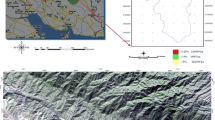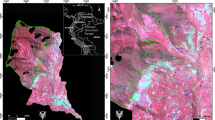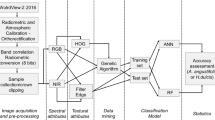Abstract
A study was conducted in central Texas to determine the potential of using remote sensing technology to distinguish Ashe juniper (Juniperus ashei Buchholz) infestations on rangelands. Plant canopy reflectance measurements showed that Ashe juniper had lower near-infrared reflectance than other associated woody plant species and lower visible reflectance than mixed herbaceous species in spring and summer. Ashe juniper could be distinguished on color-infrared aerial photographs acquired in March, April, June, and August and on QuickBird false color satellite imagery obtained in June, where it had a distinct dark reddish-brown tonal response. Unsupervised classification techniques were used to classify aerial photographic and satellite imagery of study sites. An accuracy assessment performed on a computer classified map of a photographic image showed that Ashe juniper had producer’s and user’s accuracies of 100% and 92.9%, respectively, whereas an accuracy assessment performed on a classified map of a satellite image of the same site showed that Ashe juniper had producer’s and user’s accuracies of 94.1% and 88.1%, respectively. Accuracy assessments performed on classified maps of satellite images of two additional study sites showed that Ashe juniper had producer’s and user’s accuracies that ranged from 87.1% to 96.4%. These results indicate that both color-infrared photography and false color satellite imagery can be used successfully for distinguishing Ashe juniper infestations.
Similar content being viewed by others
References
Allen, L. H., Jr., Gausman, H. W., & Allen, W. A. (1975). Solar ultraviolet radiation in terrestrial plant communities. Journal Environmental Quality, 4, 285–294.
Anderson, G. L., Prosser, C. W., Haggar, S., & Foster, B. (1999). Change detection of leafy spurge infestations using aerial photography and geographic information systems. In P. T. Tueller (Ed.), Proc. 17th biennial workshop color aerial photography and videography in resource assessment (pp. 223–230). Bethesda, MD: American Society for Photogrammetry and Remote Sensing.
Bowers, S. A., & Hanks, R. J. (1965). Reflectance of radiant energy from soils. Soil Science, 100, 130–138.
Carneggie, D. M., Schrumpf, B. J., & Mouat, D. M. (1983). Rangeland applications. In R. N. Colwell (Ed.), Manual of remote sensing, Vol. 2 (2nd edn., pp. 2325–2364). Falls Church, VA: American Society for Photogrammetry.
Congalton, R. G. (1991). A review of assessing the accuracy of classifications of remotely sensed data. Remote Sensing of Environment, 37, 35–46.
Congalton, R. G., & Green, K. (1999). Assessing the accuracy of remotely sensed data: Principles and practices (p. 137). New York, NY: Lewis Publishers.
Correll, D. S., & Johnston, M. C. (1979). Manual of the vascular plants of Texas (p. 1881). Austin, TX: University of Texas Printing Division.
Dechka, J. A., Franklin, S. E., Watmough, M. D., Bennet, R. P., & Inhstrup, D. W. (2002). Classification of wetland habitat and vegetation communities using multi-temporal IKONOS imagery in southern Saskatchewan. Canadian Journal of Remote Sensing, 28, 679–685.
Erdas, Inc. (2002). Erdas-Imagine v8.6 tour guide. Atlanta, GA: Erdas, Inc.
Everitt, J. H., Pettit, R. D., & Alaniz, M. A. (1987). Remote sensing of broom snakeweed (Gutierrezia sarothrae) and spiny aster (Aster spinosus). Weed Science, 35, 295–302.
Everitt, J. H., Richardson, A. J., & Nixon, P. R. (1986). Canopy reflectance characteristics of succulent and nonsucculent rangeland plant species. Photogrammetric Engineering and Remote Sensing, 52, 1891–1897.
Everitt, J. H., Yang, C., & Deloach, C. J. (2005). Remote sensing of giant reed with QuickBird satellite imagery. Journal of Aquatic Plant Management, 43, 81–85.
Everitt, J. H., Yang, C., Racher, B. J., Britton, C. M., & Davis, M. R. (2001). Remote sensing of redberry juniper in the Texas Rolling Plains. Journal of Range Management, 54, 254–259.
Gausman, H. W. (1985). Plant leaf optical properties in visible and near-infrared light. Graduate Studies Texas Tech University, No. 29 (p. 78). Lubbock, TX: Texas Tech University Press.
Gausman, H. W., Menges, R. M., Escobar, D. E., Everitt, J. H., & Bowen, R. L. (1977). Pubescence affects spectra and imagery of silverleaf sunflower (Helianthus argophyllus). Weed Science, 25, 437–440.
Gerbermann, A. H., Wiegand, C. L., Richardson, A. J., & Rodriguez. R. R. (1987). Diurnal soil reflectance in the 450- to 2450-nm interval as related to photographic and video sensing. Proc. 11th biennial workshop color aerial photography and videography in the plant sciences (pp. 184–195). Bethesda, MD: American Society for Photogrammetry and Remote Sensing.
Hatch, S. L., Gandhi, H. N., & Brown. N. E. (1990). Checklist of the vascular plants of Texas. MP-1655 (p. 125). College Station, TX: Texas Agricultural Experiment Station, Texas A&M University Press.
Hatch, S. L., & Pluhar, J. (1993). Texas range plants (p. 326). College Station, TX: Texas A&M University Press.
Jakubauskas, M. E., Peterson, D. L., Campbell, S. W., Campbell, S. D., Penny, D., & deNoyelles, F., Jr. (2002). Remote sensing of invasive aquatic plant obstructions in navigable waterways. Proceedings of 2002 ASPRS-ACSM Annual Conference and FIG XXII Congress, April 22–26, 2002, Washington, DC. Bethesda, MD: ASPRS. CD-ROM.
Kroll, J. C. (1980). Habitat requirements of the golden-cheeked warbler: Management implications. Journal of Range Management, 33, 60–65.
Myers, V. I., Bauer, M. E., Gausman, H. W., Hart, W. G., Heilman, J. L., McDonald, R. B., et al. (1983). Remote sensing in agriculture. In R. N. Colwell (Ed.), Manual of remote sensing (pp. 2111–2228). Falls Church, VA: American Society for Photogrammetry.
Poulton, C. E. (1970). Practical applications of remote sensing in range management. In H. A. Paulsen, Jr. & E. H. Reid (Eds.), Range and wildlife habitat evaluation – A research symposium (USDA Forest Service Misc. Publ. 1147, pp. 179–189). Washington, DC: US Government Printing Office
Richardson, A. J. (1981). Measurement of reflectance factors under daily and intermittent irradiance variations. Applied Optics, 20, 1336–1340.
Richardson, A. J., Wiegand, C. L., Gausman, H. W., Cuellar, J. A., & Gerbermann, A. H. (1975). Plant, soil, and shadow reflectance components of row crops. Photogrammetric Engineering and Remote Sensing, 41, 1401–1407.
Robinson, B. F., Bauer, M. E., DeWitt, D. P., Silva, L. F., & Vanderbilt. V. C. (1979). Multiband radiometer for field use. Measurements of optical radiations, SPIE Vol. 196 (pp. 8–15). Bellingham, WA: SPIE.
Schreiber, C. (2004). Researchers gain new insight into cedar’s impact on water. Grass Roots, 55(3), 7.
Scifres, C. J. (1980). Brush management (p. 360). College Station, TX: Texas A&M University Press.
Simpson, B. J. (1988). A field guide to Texas trees (p. 372). Austin, TX: Texas Monthly Press
Smeins, F. E., Owens, M. K., & Fuhlendorf, S. D. (1994). Biology and ecology of Ashe (Blueberry) juniper. Proceedings of 1994 Juniper Symposium (pp. 9–24). Sonora, TX: Texas A&M University Research Station.
Steel, R. G. D., & Torrie, J. H. (1980). Principles and procedures of statistics (p. 481). New York, NY: McGraw-Hill.
Taylor, C. A., Jr. (2005). Prescribed burning cooperatives: Empowering and equipping ranchers to manage rangelands. Rangelands, 27, 18–23
Thomlinson, J. R., Bolstad, P. V., & Cohen, W. B. (1999). Coordinating methodologies for scaling land-cover classifications from site-specific to global: Steps toward validating global map products. Remote Sensing of Environment, 70(1), 16–28.
Tueller, P. T. (1982). Remote sensing for range management. In C. J. Johannsen & J. L. Sanders (Eds.), Remote sensing for resource management (pp. 125–140). Ankeny, IA: Soil Conservation Society of America.
Tueller, P. T. (1989). Remote sensing technology for rangeland management applications. Journal of Range Management, 42, 442–453.
Wink, R. L., & Wright, H. A. (1973). Effects of fire on an ashe juniper community. Journal of Range Management, 26, 326–330.
Author information
Authors and Affiliations
Corresponding author
Rights and permissions
About this article
Cite this article
Everitt, J.H., Yang, C. & Johnson, H.B. Canopy Spectra and Remote Sensing of Ashe Juniper and Associated Vegetation. Environ Monit Assess 130, 403–413 (2007). https://doi.org/10.1007/s10661-006-9407-2
Received:
Accepted:
Published:
Issue Date:
DOI: https://doi.org/10.1007/s10661-006-9407-2




